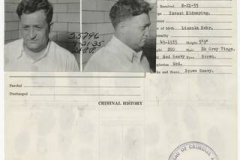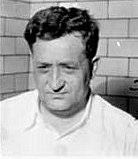Nestled in a quiet, unassuming area in St. Paul’s Highland Park neighborhood, sits a 1,300 square foot stucco home located at 1878 Jefferson Avenue. It’s history intertwines with some of the darkest chapters of the city’s corrupt past. During the height of Prohibition, St. Paul was a hotbed for organized crime. Criminal operations flourished in the shadows of the Saintly city and one of the most notorious figures in the criminal underworld, Harry “Dutch” Sawyer, set up residence in this home.
Kingpin of St. Paul’s Underworld
Sawyer, a prolific bootlegger and racketeer, became a key player in the city’s criminal network and a feared figure during St. Paul’s gangster era in the 1920 and 30s. His violent tendencies, ability to intimidate, and a knack for establishing a network of loyal enforcers allowed him to consolidate power and extend his influence across a variety of illegal activities. Sawyer had ties with some of the biggest names in organized crime, including the Barker-Karpis Gang and the infamous Al Capone.
According to declassified FBI files, Sawyer is considered the most likely suspect responsible for the infamous 1928 car-bombing hit on Irish mob boss “Dapper” Dan Hogan in the garage of his St. Paul home. Sawyer was Hogan’s assistant at the Green Lantern saloon. According to FBI files, Sawyer felt that Hogan had cheated him out of his cut from a nearby casino operation. He also allegedly resented the fact that he was never repaid $25,000 he had put up to bail Hogan out of prison a few years earlier.
Early Years
Sawyer was born into an Orthodox Jewish family in Vilna Governorate-General, Lithuania in 1890 as Harry Sandlovich. Sometime during his childhood, the family immigrated to the United States and settled in Lincoln, Nebraska. The son of a butcher, he was the fifth of seven children born to David and Gertrude Sandlovich.
In 1921, Harry fled from Lincoln to St. Paul after jumping a $1000 bond for theft. He appears in the 1922 St. Paul City directory with an address of 668 East Central Park Place. His occupation is listed in the city directory is a garage man. For the next four years Sawyer bounced around various residences in St. Paul where census records indicate he was a salesman.
Rise of a Gangster
At the height of his power, Harry Sawyer took up residence at 1878 Jefferson Avenue. The 1927 St. Paul City Directory first shows Sawyer living at the home. The 1930 Federal Census also lists this address as Sawyer’s residence and values the home at $8,500.
Historians and local experts believe that Sawyer’s residence served not only as his personal abode but also as a hub for his criminal operations. The FBI even placed his Jefferson Avenue home under surveillance in an effort to locate fugitive bank robbers Tommy Holden and Jimmy Keating, and then again when they were tracking down Verne Miller, a known member of the Barker-Karpis gang.
According to a recent owner of the home, Linda McNally, the former neighbors at 1880 Jefferson witnessed Sawyer suspiciously going through stolen U.S. Post Office mail bags obtained in a train heist sometime in the early 1930s.
Sawyer’s Downfall
On January 17, 1934, Edward Bremer, a prominent banker and the owner of the Schmidt brewery, was kidnapped from the streets of St. Paul, Minnesota. He was on his way to work, having just dropped his daughter off at school, when he was approached and abducted by members of the Barker-Karpis Gang. Sawyer was considered to be the mastermind behind this kidnapping.
After the kidnapping went down, Sawyer fled to Florida, Michigan, Ohio, Nevada, Iowa and finally to Mississippi. Ultimately, he was arrested in Pass Christian, MS on May 3, 1935.
Sawyer pled innocent to any involvement in the kidnapping. However, due to the overwhelming evidence against him, he was found guilty on January 24, 1936 and sentenced to life in Alcatraz Island Penitentiary.
After being diagnosed with spinal cancer, Sawyer was finally paroled for medical reasons in February 1955. He died in a hospital in Chicago, Illinois in June 1955 and was buried in Westlawn Cemetery.
Legacy of 1878 Jefferson Avenue
Today, 1878 Jefferson Avenue stands as a reminder of St. Paul’s criminal underworld during its heydays in the 1920s and 30s. While it no longer serves as the residence of a notorious gangster, it was a witness to a time when criminals like Harry Sawyer operated freely in the shadows of the Saintly city.
References:
- Interview with Linda McNally – owner of 1878 Jefferson Avenue, St. Paul, MN (September 2021)
- Frethem, Deborah & Schreiner Smith, Cynthia, ‘Alvin Karpis and the Barker Gang in Minnesota’, 2020, The History Press
- Maccabee, Paul F, ‘John Dillinger Slept Here’, Minnesota Historical Society Press
- 1910 Federal Census for District 0090, Lincoln Ward 7, Lancaster County, Nebraska
- 1930 Federal Census
- 1940 Federal Census
- 1922 St. Paul City Directory
- 1927 St. Paul City Directory







